Denali is a big, serious mountain with big mountain weather, geography and acclimatization issues. The following itinerary represents a basic outline of what could happen on a given day during the course of a Denali expedition. Many factors can—and likely will—contribute to cause the following schedule to change. Our guides know the mountain and may elect to stray from this itinerary in order to give you the best possible shot at getting to the summit.
DAY 1: MEET IN ANCHORAGE. Our Team Meetings are generally scheduled at 10 a.m. for an expedition orientation and equipment check. This is a very important meeting, which all climbers must attend. Be sure to arrive in Anchorage early enough to make the meeting, which may require arriving a day in advance. Our trip fee includes two night’s accommodation at the Lakefront Anchorage (formerly the Millennium Alaska Hotel), which is conveniently located and offers free airport transfers.
 DAY 2: TRAVEL TO TALKEETNA AND FLY TO THE GLACIER. We provide transportation to Talkeetna for all of our Denali climbers, using our own vans and trailers so we are not tied to a third-party’s schedule. The drive takes a bit more than two hours, and we’ll stop for coffee and snacks along the way. Once in Talkeetna, we’ll need to unload, organize, and weigh all of our equipment and supplies in preparation for our flight to the glacier. We will also finish the registration process with the National Park Service (NPS) and attend a pre-climb orientation provided by one of the NPS climbing rangers. After finalizing all the NPS admin steps, we’ll fly to the glacier, weather permitting. Once on the Southeast Fork of the Kahiltna Glacier, we’ll be busy establishing our camp for the night.
DAY 2: TRAVEL TO TALKEETNA AND FLY TO THE GLACIER. We provide transportation to Talkeetna for all of our Denali climbers, using our own vans and trailers so we are not tied to a third-party’s schedule. The drive takes a bit more than two hours, and we’ll stop for coffee and snacks along the way. Once in Talkeetna, we’ll need to unload, organize, and weigh all of our equipment and supplies in preparation for our flight to the glacier. We will also finish the registration process with the National Park Service (NPS) and attend a pre-climb orientation provided by one of the NPS climbing rangers. After finalizing all the NPS admin steps, we’ll fly to the glacier, weather permitting. Once on the Southeast Fork of the Kahiltna Glacier, we’ll be busy establishing our camp for the night.
 DAY 3: SINGLE CARRY TO 7,800′ CAMP. Departing base camp, we’ll drop down the infamous Heartbreak Hill and onto the broad Kahiltna Glacier. Our goal will be to move camp to about 7,800′, near the junction with the NE Fork of the Kahiltna Glacier. This is a moderately tough day of about 5 miles and is a good warm up for the upcoming days. Throughout the expedition we will typically follow the “climb high, sleep low” technique for better acclimatization; however, the altitude difference between Base Camp and 7,800′ Camp is minimal enough to permit us to generally “single-carry” this stretch. On the late May and June expeditions, we may climb early in the morning to avoid excessive heat and soft snow conditions on the lower glacier.
DAY 3: SINGLE CARRY TO 7,800′ CAMP. Departing base camp, we’ll drop down the infamous Heartbreak Hill and onto the broad Kahiltna Glacier. Our goal will be to move camp to about 7,800′, near the junction with the NE Fork of the Kahiltna Glacier. This is a moderately tough day of about 5 miles and is a good warm up for the upcoming days. Throughout the expedition we will typically follow the “climb high, sleep low” technique for better acclimatization; however, the altitude difference between Base Camp and 7,800′ Camp is minimal enough to permit us to generally “single-carry” this stretch. On the late May and June expeditions, we may climb early in the morning to avoid excessive heat and soft snow conditions on the lower glacier.
*Quick Stats: 8 km / 5 miles, with 365 m / 1,200’ of elevation gain. Climbing Time: ~ 4.5-6 hours.
DAY 4: HAUL LOADS UP TO KAHILTNA PASS. We’ll head out of 7,800′ Camp and carry loads up the 1,800′ Ski Hill. Several options exist for campsites between 9,000′ and 11,000′, depending upon weather, snow conditions and team strength. This is a moderately difficult carry of 7-9 miles round-trip, with 2,000′-3,000′ of elevation gain and a return to 7,800′ Camp for the night.
*Quick Stats: 12.87 km / 8 miles round trip, with 670 m / 2,200’ of elevation gain and loss. Climbing Time: ~ 6-8 hours.
 DAY 5: MOVE EVERYTHING TO 11,000′ CAMP. Our second camp is often in the 11,000’ basin at the base of Motorcycle Hill. This is an incredibly beautiful location that basks in alpenglow when the sun travels around the north side of the mountain.
DAY 5: MOVE EVERYTHING TO 11,000′ CAMP. Our second camp is often in the 11,000’ basin at the base of Motorcycle Hill. This is an incredibly beautiful location that basks in alpenglow when the sun travels around the north side of the mountain.
*Quick Stats: 7.64 km / 4.75 miles one way, with 1,036 m / 3,400’ of elevation gain. Climbing Time: ~ 5.5-7 hours.
DAY 6: BACK-CARRY DAY. This is an “active rest day” during which we drop back down and pick up the cache we left near Kahiltna Pass. It also helps give us another day to acclimatize before moving higher.
*Quick Stats: 2.4 km / 1.5 miles round trip, with 365 m / 1,200’ of elevation loss and gain. Climbing Time: 1.5 hours round-trip.
DAY 7: HAUL LOADS AROUND WINDY CORNER (13,300′). Steep snow climbing up the 1,000′ high Motorcycle Hill rewards climbers with spectacular views. The total distance for the day is about four miles round trip with a little over 2,000′ of elevation gain. Fun climbing with crampons and an ice axe gets you around Windy Corner where the upper mountain comes into view. Have your camera ready!
*Quick Stats: 6.43 km / 4 miles, with 700 m / 2,300’ of elevation gain. Climbing Time: ~ 6-7 hours round-trip.
 DAY 8: MOVE CAMP TO 14,200′. This is usually a long, hard day. Our next camp is generally located at the well-equipped 14,200’ Camp in the expansive Genet Basin. Loads are getting lighter and the air is getting thinner. Upon arrival, everyone will need to pitch in to build our camp as we need to fortify our tents due to the possibility of severe winds.
DAY 8: MOVE CAMP TO 14,200′. This is usually a long, hard day. Our next camp is generally located at the well-equipped 14,200’ Camp in the expansive Genet Basin. Loads are getting lighter and the air is getting thinner. Upon arrival, everyone will need to pitch in to build our camp as we need to fortify our tents due to the possibility of severe winds.
*Quick Stats: 4 km / 2.5 miles, with 914 m / 3,200’ of elevation gain. Climbing Time: ~ 5-7 hours.
DAY 9: BACK-CARRY DAY. This is another “active rest day,” during which the team will descend from Genet Basin to the Windy Corner cache and bring everything up to 14,200′. We’ll spend the afternoon going over climbing techniques that we will use in the upcoming days.
*Quick Stats: 1.6 km / 1 mile round-trip, with 213 m / 700’ of elevation loss and gain. Climbing Time: ~ 1.5 hours round-trip.
 DAY 10: CLIMB UP THE HEADWALL TO THE RIDGE. Our goal is to cache supplies up on the ridge above us and return to 14,200′. Climbing up the “Headwall” (the section of route with fixed lines running from 15,500′ to 16,100′) with a heavy pack makes this one of the more strenuous days of the trip because of the steep terrain, heavy pack and thinning air. The views from the ridge can be as breathtaking as the rarefied air!
DAY 10: CLIMB UP THE HEADWALL TO THE RIDGE. Our goal is to cache supplies up on the ridge above us and return to 14,200′. Climbing up the “Headwall” (the section of route with fixed lines running from 15,500′ to 16,100′) with a heavy pack makes this one of the more strenuous days of the trip because of the steep terrain, heavy pack and thinning air. The views from the ridge can be as breathtaking as the rarefied air!
*Quick Stats: 3.8 km / 2.4 miles round-trip, with 670 m / 2,200’ of elevation gain and loss. Climbing Time: ~ 5-7 hours.
DAY 11: REST DAY. It is often prudent to take a rest/acclimatization day prior to moving up to High Camp. Many climbers feel this day really helps their acclimatization.
DAY 12: MOVE TO HIGH CAMP. Weather and team strength will again determine this decision. While there is a camp site at 16,100′, it is very exposed, so we usually push for the 17,200′ site, which is more secure and the better choice for camp. This is a really tough day, as our loads are big and some of the the terrain we will negotiate is steep. Rewards for our work are in the awesome climbing along the ridge. Weaving in and out of the rocks and occasionally walking a knife-edge stretch, combined with big exposure, make this day one of the most memorable of the route.
*Quick Stats: 3.21 km / 2 miles, with 914 m / 3,000’ of elevation gain. Climbing Time: ~ 6-8 hours.
DAY 13: REST DAY. Moving to 17,200’ and getting High Camp established can be a huge day, so we usually take a rest day before attempting the summit. Circumstances could mean that we do not take this rest day, but if possible, we prefer to take it.
 DAY 14: SUMMIT DAY. If the weather is favorable, we’ll push for the summit. It is important to be patient on a big peak like Denali and we will only try for the summit when the weather is good; meaning mostly clear and calm. Our guide staff is the most experienced on the mountain and your guides will make this sometimes difficult decision. The round-trip climb will take eight to twelve hours or more. Usually you will depart camp early (7-10 a.m.), climb up to Denali Pass (18,000’) and follow the route past Arch Deacon’s Tower and the Football Field to the slopes leading to the Summit Ridge. On this spectacular ridge you can often see down into the Ruth Glacier with views of beautiful peaks such as the Moose’s Tooth, Mount Huntington and Mount Hunter.
DAY 14: SUMMIT DAY. If the weather is favorable, we’ll push for the summit. It is important to be patient on a big peak like Denali and we will only try for the summit when the weather is good; meaning mostly clear and calm. Our guide staff is the most experienced on the mountain and your guides will make this sometimes difficult decision. The round-trip climb will take eight to twelve hours or more. Usually you will depart camp early (7-10 a.m.), climb up to Denali Pass (18,000’) and follow the route past Arch Deacon’s Tower and the Football Field to the slopes leading to the Summit Ridge. On this spectacular ridge you can often see down into the Ruth Glacier with views of beautiful peaks such as the Moose’s Tooth, Mount Huntington and Mount Hunter.
*Quick Stats: 8 km / 5 miles round-trip, with 914 m / 3,000’ of elevation gain and loss. Climbing Time: ~ 9-12+ hours
 ***Summit Day is Serious***
***Summit Day is Serious***
The weather needs to be good and everyone attempting the summit must have demonstrated that they can reasonably give it a shot. This is often the most grueling day of the expedition (some climbers say of their lives!). The guides have the ultimate decision as to when the team will make a summit bid. The guides also have the discretion to decide that a team member has not shown that he or she is capable to make a summit bid. Such occurrences are rare; but remember getting everyone home healthy is the primary concern.
DAYS 15-16: DESCENT. The descent from High Camp takes one to two days, depending on the team’s strength and motivation to get home. The descent can beat you up more than the ascent, as we often shoulder our heaviest loads of the trip hiking down from High Camp to Camp 2. Weather dictates when we can fly out to Talkeetna for food and showers. Not much beats a steak and salad at the West Rib Tavern after working hard on Denali!
DAYS 17-23 CONTINGENCY DAYS. We build seven “contingency days” into our schedule. Denali has a well-deserved reputation for arctic weather, and it is common to take weather days at some point on the mountain.
DAY 24: RETURN TO ANCHORAGE AND FLY HOME. We will provide group transportation back to Anchorage and you can make plans to fly home as early as this evening. If you are staying in Alaska, we are happy to assist in making any necessary lodging reservations; however, lodging after the climb is not included in trip cost. This is a true transition day from the intensity of the mountain to the relative “big city” life of Anchorage.










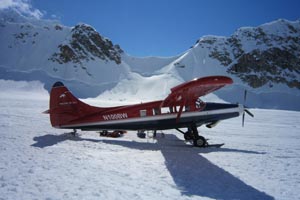 DAY 2: TRAVEL TO TALKEETNA AND FLY TO THE GLACIER. We provide transportation to Talkeetna for all of our Denali climbers, using our own vans and trailers so we are not tied to a third-party’s schedule. The drive takes a bit more than two hours, and we’ll stop for coffee and snacks along the way. Once in Talkeetna, we’ll need to unload, organize, and weigh all of our equipment and supplies in preparation for our flight to the glacier. We will also finish the registration process with the National Park Service (NPS) and attend a pre-climb orientation provided by one of the NPS climbing rangers. After finalizing all the NPS admin steps, we’ll fly to the glacier, weather permitting. Once on the Southeast Fork of the Kahiltna Glacier, we’ll be busy establishing our camp for the night.
DAY 2: TRAVEL TO TALKEETNA AND FLY TO THE GLACIER. We provide transportation to Talkeetna for all of our Denali climbers, using our own vans and trailers so we are not tied to a third-party’s schedule. The drive takes a bit more than two hours, and we’ll stop for coffee and snacks along the way. Once in Talkeetna, we’ll need to unload, organize, and weigh all of our equipment and supplies in preparation for our flight to the glacier. We will also finish the registration process with the National Park Service (NPS) and attend a pre-climb orientation provided by one of the NPS climbing rangers. After finalizing all the NPS admin steps, we’ll fly to the glacier, weather permitting. Once on the Southeast Fork of the Kahiltna Glacier, we’ll be busy establishing our camp for the night.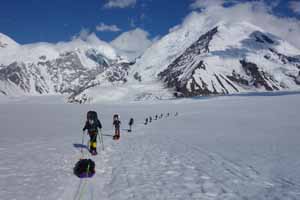 DAY 3: SINGLE CARRY TO 7,800′ CAMP. Departing base camp, we’ll drop down the infamous Heartbreak Hill and onto the broad Kahiltna Glacier. Our goal will be to move camp to about 7,800′, near the junction with the NE Fork of the Kahiltna Glacier. This is a moderately tough day of about 5 miles and is a good warm up for the upcoming days. Throughout the expedition we will typically follow the “climb high, sleep low” technique for better acclimatization; however, the altitude difference between Base Camp and 7,800′ Camp is minimal enough to permit us to generally “single-carry” this stretch. On the late May and June expeditions, we may climb early in the morning to avoid excessive heat and soft snow conditions on the lower glacier.
DAY 3: SINGLE CARRY TO 7,800′ CAMP. Departing base camp, we’ll drop down the infamous Heartbreak Hill and onto the broad Kahiltna Glacier. Our goal will be to move camp to about 7,800′, near the junction with the NE Fork of the Kahiltna Glacier. This is a moderately tough day of about 5 miles and is a good warm up for the upcoming days. Throughout the expedition we will typically follow the “climb high, sleep low” technique for better acclimatization; however, the altitude difference between Base Camp and 7,800′ Camp is minimal enough to permit us to generally “single-carry” this stretch. On the late May and June expeditions, we may climb early in the morning to avoid excessive heat and soft snow conditions on the lower glacier. DAY 5: MOVE EVERYTHING TO 11,000′ CAMP. Our second camp is often in the 11,000’ basin at the base of Motorcycle Hill. This is an incredibly beautiful location that basks in alpenglow when the sun travels around the north side of the mountain.
DAY 5: MOVE EVERYTHING TO 11,000′ CAMP. Our second camp is often in the 11,000’ basin at the base of Motorcycle Hill. This is an incredibly beautiful location that basks in alpenglow when the sun travels around the north side of the mountain.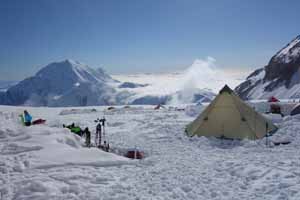 DAY 8: MOVE CAMP TO 14,200′. This is usually a long, hard day. Our next camp is generally located at the well-equipped 14,200’ Camp in the expansive Genet Basin. Loads are getting lighter and the air is getting thinner. Upon arrival, everyone will need to pitch in to build our camp as we need to fortify our tents due to the possibility of severe winds.
DAY 8: MOVE CAMP TO 14,200′. This is usually a long, hard day. Our next camp is generally located at the well-equipped 14,200’ Camp in the expansive Genet Basin. Loads are getting lighter and the air is getting thinner. Upon arrival, everyone will need to pitch in to build our camp as we need to fortify our tents due to the possibility of severe winds.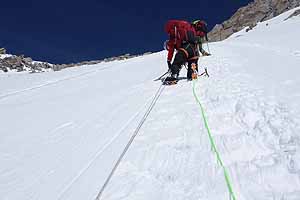 DAY 10: CLIMB UP THE HEADWALL TO THE RIDGE. Our goal is to cache supplies up on the ridge above us and return to 14,200′. Climbing up the “Headwall” (the section of route with fixed lines running from 15,500′ to 16,100′) with a heavy pack makes this one of the more strenuous days of the trip because of the steep terrain, heavy pack and thinning air. The views from the ridge can be as breathtaking as the rarefied air!
DAY 10: CLIMB UP THE HEADWALL TO THE RIDGE. Our goal is to cache supplies up on the ridge above us and return to 14,200′. Climbing up the “Headwall” (the section of route with fixed lines running from 15,500′ to 16,100′) with a heavy pack makes this one of the more strenuous days of the trip because of the steep terrain, heavy pack and thinning air. The views from the ridge can be as breathtaking as the rarefied air! DAY 14: SUMMIT DAY. If the weather is favorable, we’ll push for the summit. It is important to be patient on a big peak like Denali and we will only try for the summit when the weather is good; meaning mostly clear and calm. Our guide staff is the most experienced on the mountain and your guides will make this sometimes difficult decision. The round-trip climb will take eight to twelve hours or more. Usually you will depart camp early (7-10 a.m.), climb up to Denali Pass (18,000’) and follow the route past Arch Deacon’s Tower and the Football Field to the slopes leading to the Summit Ridge. On this spectacular ridge you can often see down into the Ruth Glacier with views of beautiful peaks such as the Moose’s Tooth, Mount Huntington and Mount Hunter.
DAY 14: SUMMIT DAY. If the weather is favorable, we’ll push for the summit. It is important to be patient on a big peak like Denali and we will only try for the summit when the weather is good; meaning mostly clear and calm. Our guide staff is the most experienced on the mountain and your guides will make this sometimes difficult decision. The round-trip climb will take eight to twelve hours or more. Usually you will depart camp early (7-10 a.m.), climb up to Denali Pass (18,000’) and follow the route past Arch Deacon’s Tower and the Football Field to the slopes leading to the Summit Ridge. On this spectacular ridge you can often see down into the Ruth Glacier with views of beautiful peaks such as the Moose’s Tooth, Mount Huntington and Mount Hunter.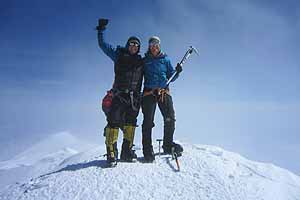 ***Summit Day is Serious***
***Summit Day is Serious***